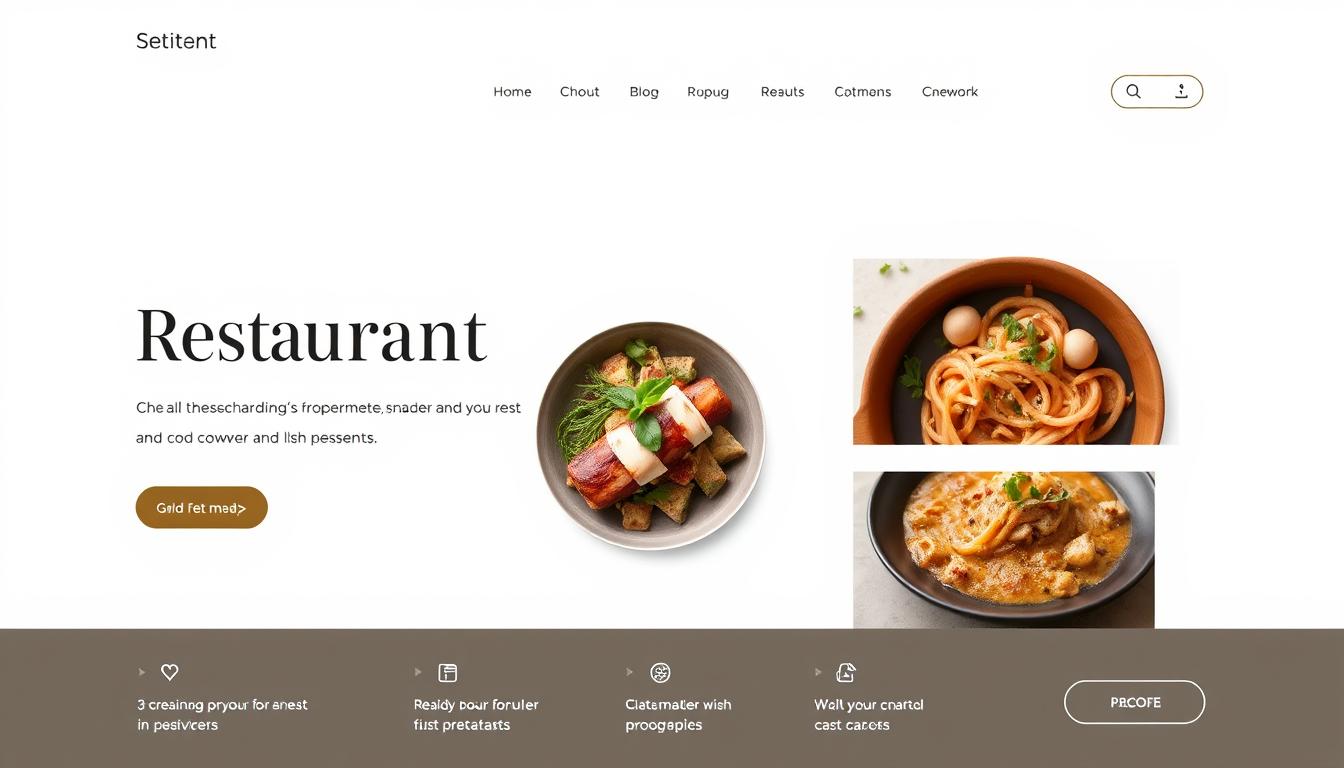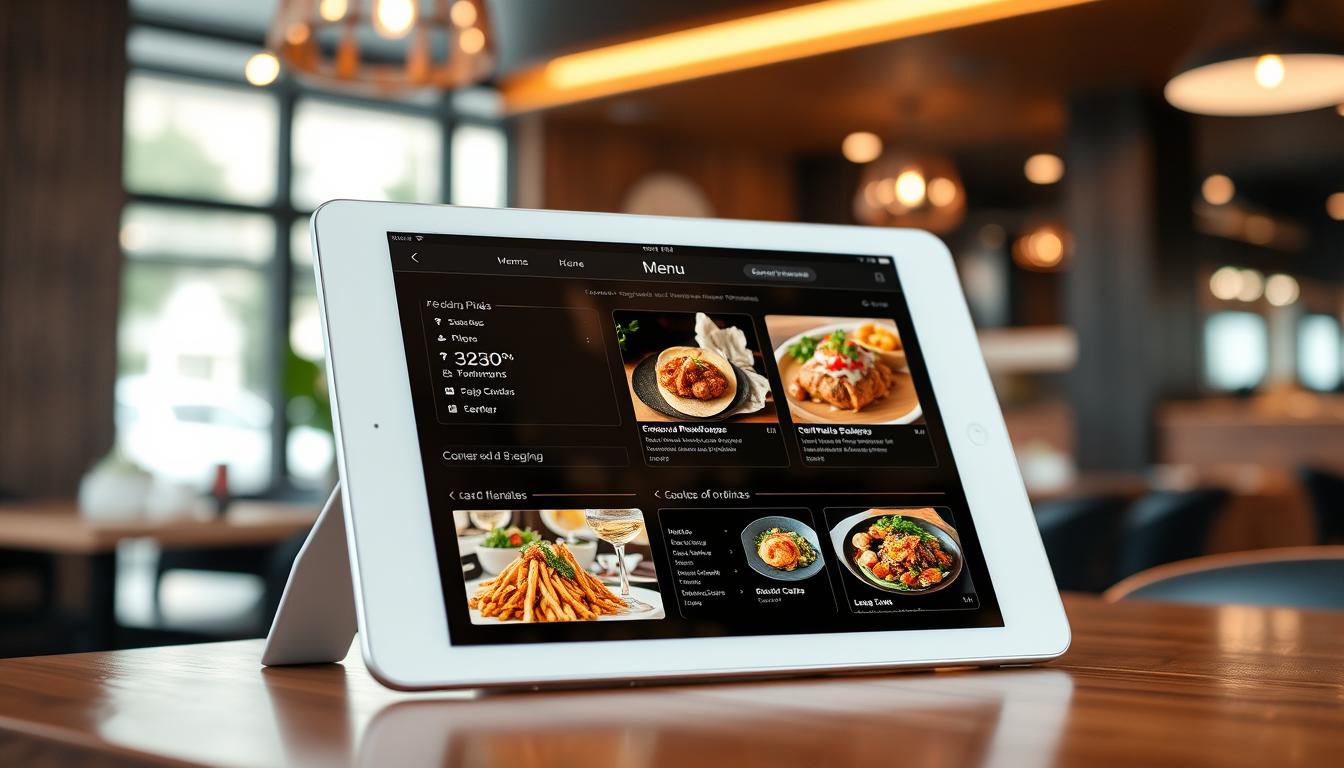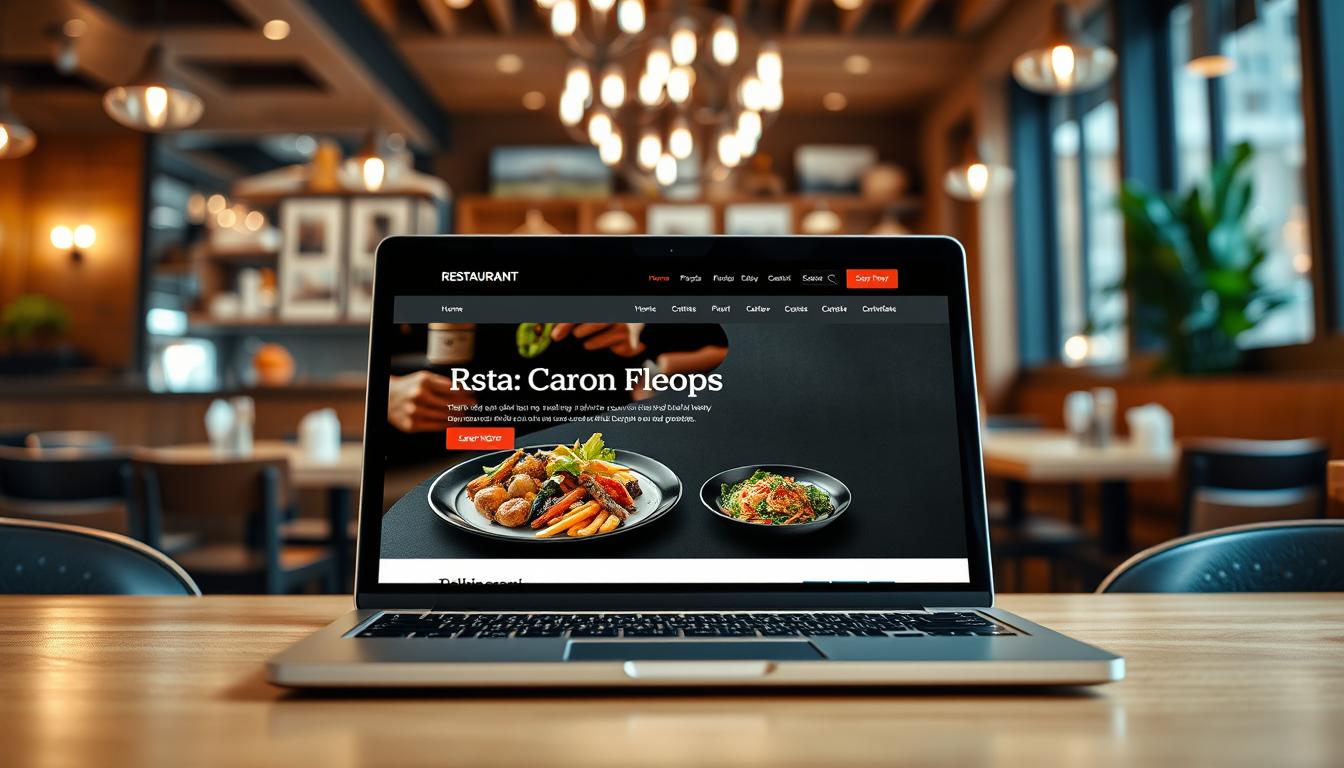In today’s digital world, having a strong online presence is key for restaurants. Your website is like your brand’s virtual face. It greatly influences people’s choices when they’re deciding where to eat.
With 90% of guests checking out a restaurant online before going1, and 57% looking at the website before making a choice1, a good website is vital. It helps attract and keep customers, boosting your brand and sales.
As 70% of diners use mobiles to find restaurants each year2, adding online ordering and reservations to your site is a big plus. It makes things easier for customers and helps your business run smoother2. SEO is also important for your website to show up in search results and get more visitors2.
Keeping your site fresh with new content keeps people interested and tells search engines you’re active2. Plus, linking your site to social media can really boost your online presence. It increases engagement and helps you connect with customers2.
Why Your Restaurant Needs an Outstanding Website
In today’s digital world, having a strong online presence is key for any restaurant’s success. Over 90% of guests check a restaurant online before visiting3. This means most new customers find you on the internet. Also, 57% of them look at your website before deciding where to eat3.
Your website is often the first thing a customer sees of your brand. It can greatly influence their choice to visit you.
A well-designed website does more than just attract new customers. 48% of users judge a business’s credibility by its website design3. When ordering food online, design is even more important, with 67% preferring websites or apps4.
Statistics Highlighting the Importance of a Restaurant Website
- 77% of diners check a restaurant’s website before deciding to dine, showing the need for a good website4.
- 45% of diners look for food photos on restaurant websites, highlighting the importance of quality images4.
- 70% of website visitors use mobile devices, making mobile-friendly design essential4.
- Text-based menus are preferred for their ease of editing and search engine readability4.
- Websites must follow ADA and WCAG guidelines to avoid legal issues and ensure accessibility4.
In summary, a well-designed restaurant website is now a must-have, not a luxury. It boosts your brand, attracts new customers, and keeps you competitive34.
Mobile-Friendly Design: A Must-Have for Restaurant Websites
In today’s world, over 60% of digital restaurant orders come from mobile devices5. With 54.4% of web traffic from mobiles6, Google favors mobile-friendly sites in search results. If your site isn’t mobile-friendly, you might miss out on many potential customers.
When designing your website, you have three main choices: mobile-first, adaptive, or responsive design. The right choice depends on your audience and needs. A professional website design company can help pick the best option for your site. This ensures a great user experience, no matter the device.
- Mobile-first design focuses on the mobile experience, making sure your site works well on small screens first.
- Adaptive design creates different versions of your site for various screen sizes and devices using CSS media queries.
- Responsive design uses flexible layouts and CSS to adjust your site’s content and layout for any screen size.
Investing in a mobile-friendly website boosts your online presence and user experience. With 59% of diners checking a restaurant’s online before eating out7, and 40% leaving if a site loads slowly7, a mobile-optimized site is crucial. It can help attract and keep customers in the digital world.
Importance of Website Loading Speed
In today’s digital world, how fast your restaurant’s website loads is key. Over 60% of people search for restaurants on mobile devices8. If your site isn’t mobile-friendly, half of users will visit less often, even if they like your business9. Making sure your site loads quickly is vital for keeping customers.
Google says a page should load in two seconds for a good user experience9. Two extra seconds can double the bounce rate9. Also, 53% of mobile users will leave if a page takes over three seconds to load9. This is especially true for restaurants, as 90% of guests check online before visiting10. And 35% find restaurants through online reviews and websites10.
Tactics to Optimize Page Load Times
To give your restaurant’s website a smooth experience, try these tips to speed it up:
- Compress your images: Make your images smaller without losing quality to speed up your site.
- Minimize the number of redirects: Too many redirects can slow down your site a lot.
- Enable lazy loading: This delays loading non-essential elements until scrolled to, speeding up initial loads.
- Choose the right hosting provider and CMS platform: Pick a reliable host and a fast CMS to boost your site’s speed.
By focusing on website loading speed, you can make your site better, attract more visitors, and boost your restaurant’s online image.
Less is More: Minimalist Design for Maximum Impact

In web design, simplicity often wins. A minimalist website for your restaurant can be both beautiful and useful. It grabs your customers’ attention. Minimalism started in the 1960s and 1970s in art and design11. Now, it’s a big trend in web design, focusing on simplicity and ease of use11.
Minimalist sites use empty space to highlight important parts11. This empty space helps organize content and makes the site easier to use11. They often stick to simple colors like black and white, but any color works well11.
Fonts are key in minimalist design, making the site look good and unique11. High-quality images and videos are also crucial, as they fill space and share your brand’s message11. With the right content and design, minimalist sites can be both beautiful and easy to use12.
Many websites show the power of minimalism in design. Copilot Capital, United Digital Technologies, and others use it to improve their sites’ usability and user experience11.
By going minimalist, your restaurant’s website can stand out. It will look great and be easy to use, attracting more customers12.
High-Quality Food Photography: A Visual Feast
Exceptional food photography can make your restaurant stand out. It’s a great way to improve your visual branding and attract more customers13. While taking photos yourself might seem easy, hiring a pro can make a big difference. They can create stunning images that grab attention and leave a lasting impression13.
Professional food photographers know how to make your dishes look amazing. They use their skills in composition, lighting, and styling to create images that make you want to try your food. These images will also match your brand’s identity13.
High-quality food photography is very important1314. In fact, 82% of millennials choose a restaurant based on its online photos13. Seeing great photos of food can also make people more likely to order it13. By investing in professional photos, you can improve your brand’s look and influence your customers’ choices14.
Also, using photos from customers on platforms like Instagram Stories can make your restaurant more engaging. It turns customers into brand supporters by sharing their experiences13. Mixing these photos with professional ones can create a strong and appealing visual identity13.
In the competitive world of restaurants, great food photos can help you stand out. Working with a photographer who knows how to showcase food can make your photos unforgettable. This can improve your customers’ experience and help your business grow13.
Optimizing Your Online Menu for User Experience

Your online menu is key to a great customer experience. Today, 77% of diners check a restaurant’s website before visiting15. So, it’s important to make your menu easy to use and look good.
Forget about PDF menus that are hard to use on phones and bad for search engines. Create a special menu page with clear categories and short, detailed descriptions. Add great food photos too15. This makes your menu more appealing and can lead to more sales.
Letting customers customize their meals can increase what they spend15. By offering menu options, you can sell more and make more money.
With 71% of people ordering food on their phones in 202216, your website must work well on mobile. Make sure your menu is easy to use on all devices. This will help more people order and make your website more effective.
Your website is often the first thing people see. A good online menu can leave a great impression. By focusing on user experience, you can attract more customers and keep them coming back.
“39% of consumers state that a restaurant’s website influences their decision to try a new restaurant for delivery or takeout.”16
In short, a well-designed online menu is a smart investment. It can improve your brand and make customers happy. By focusing on online menu optimization, you can succeed in the digital world161715.
website for restaurant branding: Enhancing Online Presence
Your restaurant’s website is like a digital version of your place. It should show off your brand to customers18. A good website makes your brand stand out and shows you’re different from others18. It’s important to make sure your website looks good and feels right for your restaurant.
Restaurant website branding is key to your online look19. Things like fonts, colors, and your logo all help shape your brand online19. Keeping these things the same helps make your brand easy to remember and connect with.
But online branding is more than just looks. It’s also about being active online through your website and social media20. 77% of people check a restaurant’s website before they decide to go or order food20. So, having a strong online presence is crucial for getting and keeping customers.
Investing in a good website can really help show off your restaurant’s brand18. It not only draws in new customers but also keeps the ones you have coming back.
| Key Branding Elements | Importance for Restaurants |
|---|---|
| Typography | Reflects the restaurant’s style and appeals to the target audience19 |
| Color Palette | Casual restaurants use brighter colors, while formal establishments opt for muted tones and neutrals19 |
| Ambiance | Aligns with the chosen color palette, typography, and imagery to create a cohesive brand identity19 |
| Logo Design | Incorporates the restaurant’s typography, color palette, and imagery to reflect the restaurant’s style and vibe19 |
| Digital Branding | Maintains a consistent brand online through the restaurant’s website, social media, and other digital platforms19 |
By focusing on restaurant website branding, online branding, and a strong digital presence, you can share your restaurant’s unique story with customers182019.
The Power of Social Media Integration
In today’s world, linking your restaurant’s website with social media is key. It boosts your online presence and gets more people involved21. Sharing new menu items, deals, and sneak peeks on Facebook, Instagram, and Twitter helps you connect better with customers. It also makes your brand more known21. Plus, it can send more people to your website, leading to more orders and bookings21.
There are many good things about using social media for restaurants22. Sharing the latest news, like posts and images, can get more people talking and interacting22. Adding social media to your website can also reach more people, even those who wouldn’t find you otherwise22.
Good social media use can bring more visitors to your site, leading to more bookings22. Showing off good reviews and feedback on social media can make you look more trustworthy22. It also helps your campaigns work better and shows off your achievements and partnerships on your website22.
To get the most out of social media, use commenting systems to get real feedback and start conversations22. Adding ‘Follow Us’ buttons can help people stay connected and visit your social media sites more22. Using social share plugins can also make your content spread fast, which is great for getting noticed online22.
By using social media well, you can improve your social media integration, restaurant marketing, and customer engagement. This can help your business grow and succeed.
“Integrating your restaurant’s website with social media platforms can have a significant impact on your online presence and customer engagement.”
Continuous Improvement: A/B Testing and Analytics
We believe in the power of data-driven design and ongoing website optimization at our restaurant. By using A/B testing and analyzing website analytics, we improve our online presence. This helps us serve our customers better and grow our business.
Strategies for Ongoing Website Optimization
A/B testing is a key tool for us. It divides a sample audience into two groups23. One group is the control, and the other is the variant. We then compare metrics like conversion rates to see which version works better23.
Statistical significance is important in this process23. It ensures any differences are due to our changes, not chance. This approach helps us improve our website and marketing strategies based on real user behavior23.
We test different layouts and calls-to-action to find what works best23. This data-driven decision-making helps us increase conversions and ROI23.
We also monitor our website analytics to find areas for improvement24. We look at email open rates and cart abandonment rates. This helps us understand our audience better and tailor our strategies24.
Our commitment to A/B testing and data analysis has paid off25. For example, a simple redesign of our homepage hero image increased sign-ups by 6%25. Optimizing our site navigation also boosted revenue per visitor by 53.8%25.
We’ve seen big improvements in customer engagement and conversion rates25. This includes using customer testimonials and optimizing email alignment. By focusing on data-driven design and website optimization, we keep our online presence effective and engaging. This commitment is key to our restaurant’s success and growth.
Staying Ahead of the Curve: Restaurant Website Design Trends
In the fast-changing digital world, keeping up with design trends is key. Trends like virtual tours and augmented reality menus are changing the game. They also include optimizing for voice search, making websites more user-friendly26.
Minimalist design is becoming popular. It focuses on simple layouts, lots of white space, and high-quality images. This makes websites look better and work better for users26. Dark mode is also on the rise. It’s good for your eyes, makes images pop, and saves battery life, especially at night26.
Micro-interactions, like animations and interactive menus, are getting more attention. They make websites more fun to use. Personalization, using data to tailor experiences, also boosts engagement and loyalty26.
New tech is shaping website design. Augmented reality lets users see menus and tours before they visit. Voice search is also key, making websites easier to find with smart speakers26.
Sustainability is becoming a big trend. Restaurants are using green hosting and highlighting eco-friendly practices. Looking at successful websites can inspire improvements26.
To stay ahead, restaurants need to keep up with design trends. They should use new tech and meet customer needs27. By doing this, they can improve their online image, attract more customers, and increase loyalty28.
| Trend | Impact |
|---|---|
| Mobile Responsiveness | Over 60% of internet users access online content using mobile devices28. |
| Minimalistic Design | Websites with minimalist design experience an average of 40% longer user sessions compared to cluttered designs28. |
| High-Quality Visuals | Restaurants with professional photography on their website see a 25% increase in online reservations28. |
| Online Ordering | Websites with seamless online ordering systems report a 30% increase in online sales28. |
| Social Media Integration | Restaurants with social media integration witness a 20% growth in customer engagement28. |
| Sustainability | 70% of consumers are more likely to choose an eco-friendly restaurant based on its sustainability initiatives28. |
| Local Ingredients | Over 80% of diners prefer restaurants that highlight the use of local and seasonal ingredients28. |
| AI Chatbots | Websites using AI chatbots report a 45% decrease in customer service response time28. |
| Voice Search Optimization | Websites optimized for voice search experience a 30% increase in organic traffic28. |
| Augmented Reality Menus | Restaurant websites with AR menus show a 15% rise in average order value28. |
| Interactive Features | Websites with interactive elements see a 50% increase in user engagement28. |
By embracing these trends, restaurants can improve their online presence. They can engage with their audience and grow in a competitive digital world27.
Conclusion
A well-designed website is key for restaurants wanting to grow their brand and increase online orders and reservations. It should be easy to use on mobile devices29, load quickly29, and follow simple design rules29. High-quality food photos30 and social media integration30 help show off our brand’s unique identity. This attracts new customers2930.
Consistency in branding29 and a clear concept are crucial for a strong brand. Knowing our audience30 and the local dining scene29 helps us stand out. This way, we create a memorable experience for our customers2930.
As the digital world keeps changing, we must keep our website up to date30. This ensures it works well for our online presence and marketing. By following these tips, we can build trust29, keep customers coming back2930, and ensure our restaurant’s success2930.
Source Links
- https://nextrestaurants.com/mobile-marketing/5-tips-to-boost-your-restaurants-online-orders-with-stellar-website-design/
- https://brachadesigns.com/revamp-your-restaurants-online-presence-with-stellar-website-design/
- https://www.restaurant-website-builder.com/restaurant-website-features
- https://www.getbento.com/blog/the-10-essential-elements-of-a-restaurant-website/
- https://blog.hubspot.com/website/restaurant-website-design
- https://thedigitalrestaurant.com/restaurant-websites-best-design-features/
- https://www.touchbistro.com/blog/restaurant-website-design/
- https://restaurantsmarketing.com.au/blog/why-is-mobile-optimisation-important-for-restaurant-websites/
- https://blog.hubspot.com/website/website-performance
- https://www.marketpath.com/blog/why-restaurants-need-a-website
- https://weblium.com/blog/examples-of-minimalist-website-design/
- https://www.wix.com/blog/minimalist-websites
- https://restaurantsmarketing.com.au/blog/visual-feast-the-impact-of-food-photography-on-restaurant-marketing/
- https://hal.news/insight/visual-feast-how-to-create-tempting-images-for-your-restaurants-branding/
- https://www.touchbistro.com/blog/3-tips-for-creating-an-awesome-online-menu/
- https://get.doordash.com/en-ca/blog/building-restaurant-website
- https://www.vdigitalservices.com/optimizing-your-restaurant-website-for-success/
- https://computools.com/restaurant-web-design-steps-to-boost-online-presence/
- https://get.popmenu.com/post/restaurant-branding-guide
- https://marketingwebsites.ca/restaurant-website-design/
- https://jetpack.com/blog/social-media-for-restaurants/
- https://seoforestaurants.com/social-media-integration/
- https://trymata.com/blog/what-is-a-b-testing/
- https://vwo.com/ab-testing/
- https://blog.hubspot.com/marketing/a-b-testing-experiments-examples
- https://medium.com/@anie_maz/top-8-restaurant-website-design-trends-in-2024-e5e35da0ff10
- https://hyperlinksmedia.com/fresh-restaurant-website-design-strategies-for-success-in-2024/
- https://aramwills.wixsite.com/home/post/future-forward-trends-for-the-best-restaurant-website-design
- https://www.restaurant-website-builder.com/branding-for-restaurants
- https://lesroches.edu/blog/restaurant-branding/


